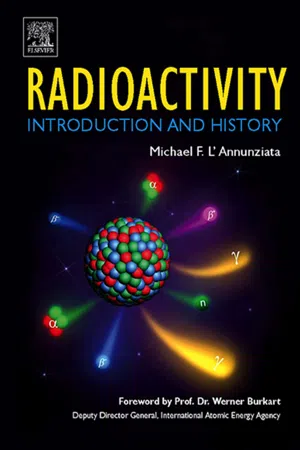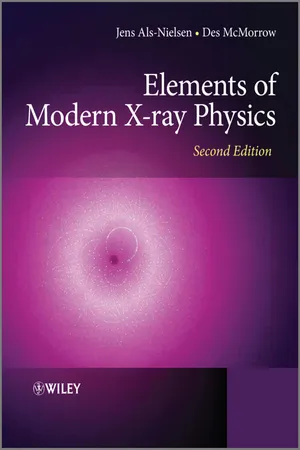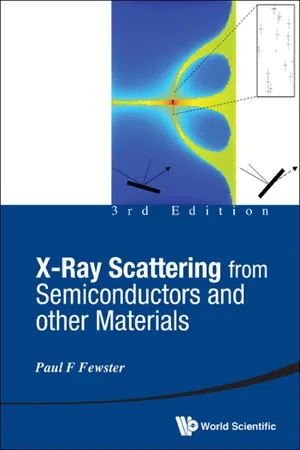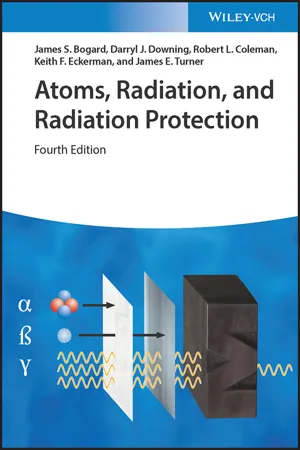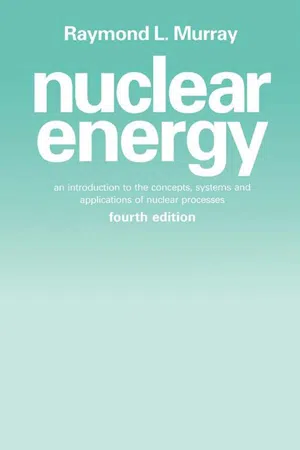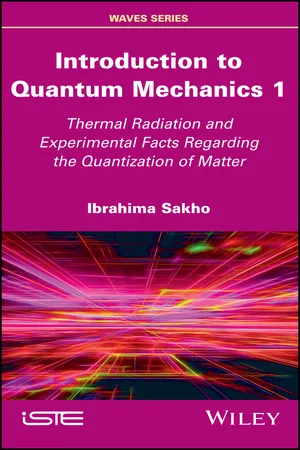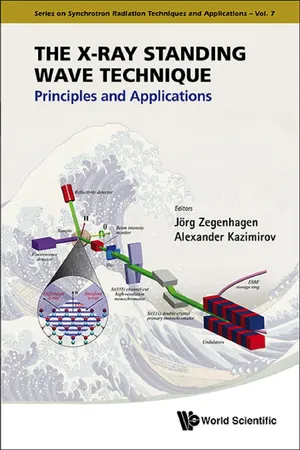Physics
Compton Scattering
Compton scattering is a phenomenon in which a photon collides with an electron, resulting in the photon losing energy and changing direction. This process demonstrates the particle-like behavior of light and provides evidence for the dual nature of electromagnetic radiation. Compton scattering is a crucial concept in understanding the interaction between photons and matter.
Written by Perlego with AI-assistance
Related key terms
Related key terms
1 of 4
Related key terms
1 of 3
10 Key excerpts on "Compton Scattering"
- eBook - ePub
- Michael F. L'Annunziata(Author)
- 2007(Publication Date)
- Elsevier Science(Publisher)
Compton, 1923a ) known as the Compton effect. It was for this work that Compton received the Nobel Prize for Physics 1927. He studied the x-radiation scattered by low atomic weight materials. By irradiating substances with homogeneous or monochromatic x-rays, that is, x-rays of a specific wavelength, he found that the rays would be divided into two lines or wavelengths, one line would be of one and the same wavelength as the incident radiation, and the other would be the scattered rays of a longer wavelength. The change in wavelength would be independent of the irradiated material, but dependent on the angle between the incident and scattered rays.Compton explained this phenomenon on the basis of the quantum theory of light. In his account for the quantum theory of the scattering of x-rays and gamma rays by light elements Compton (1923a) statedThe hypothesis is suggested that when an x-ray quantum is scattered it spends all of its energy and momentum upon some particular electron. This electron, in turn, scatters the ray in some definite direction. The change in momentum of the x-ray quantum, due to the change in its direction of propagation, results in a recoil of the scattering electron. The energy in the scattered quantum is thus less than the energy of the primary quantum by the kinetic energy of recoil of the scattering electron.Compton elucidated that, of the total energy of the primary beam incident on a material, a fraction of the energy reappears as scattered radiation, while the remainder is absorbed and transformed into kinetic energy of recoil of the scattering electrons. The Compton effect is illustrated in Figure III.2 . The scattered quantum is of longer wavelength (λ′) and thus lower in energy than the incident quantum of shorter wavelength (λ). The change in wavelength can be calculated as a function of the angle of deflection of the scattered ray as derived by Compton according to the equationFigure III.2 The Compton effect. An incident x-ray or gamma-ray photon is deflected through an angle φby an electron, which, in turn, recoils at an angle U, taking part of the energy of the photon. The symbol ß represents the relative phase velocity of the recoil electron, that is, the ratio of the velocity of the electron to the velocity of light.(Adapted from Compton (1927) - eBook - ePub
Practical Radiotherapy
Physics and Equipment
- Pam Cherry, Angela M. Duxbury, Pam Cherry, Angela M. Duxbury(Authors)
- 2019(Publication Date)
- Wiley-Blackwell(Publisher)
As the energy of the incident photon increases, the binding energy of the orbital electrons in the attenuating material becomes almost insignificant in comparison. The electron is no longer bound and is considered to be a ‘free electron’. During a Compton scatter interaction the following steps occur:- The incident photon collides with a free electron and transfers some of its energy to the free electron in the form of kinetic energy.
- The electron recoils from the collision and is ejected at speed from the atom in either a forward or a side direction to travel through the attenuating material (Figure 5.4 ).
- The electron undergoes many electron–particle interactions, dissipating its kinetic energy before coming to rest.
- Radiation damage occurs as a result of electron–particle interactions.
- The incident photon continues but is deflected from its original path (Figure 5.4 ) and possesses less energy, as it has transferred an amount to the electron.
- The scattered photon has a reduced frequency and increased wavelength compared with the incident photon.
Compton Scattering.FIGURE 5.4Given that the total energy in a system must remain constant, it follows that the energy of the electron plus that of the scattered photon must be equal to the total energy of the incident photon. The electron and scattered photon therefore have an inverse relationship, i.e. if the electron recoils with a large kinetic energy then the scattered photon has an associated small amount of energy. This produces a spectrum of electron and scattered photon energies. Momentum is also conserved in this collision interaction by the electron removing some of the momentum of the incoming photon.It follows therefore that the energy and the angles of travel of the recoil electron and the scattered photon are interconnected by this need for conservation of energy and momentum. In a situation of maximum energy transfer, i.e. a direct hit, the electron is ejected in the direction of travel of the incident photon whereas the scattered photon is deflected through 180°. Conversely, in a situation of minimum energy transfer, the electron recoils at an angle of 90° to the original direction of travel of the incident photon with minimal scattering of the photon. Most collisions lie somewhere between these two extremes. - eBook - ePub
- Jens Als-Nielsen, Des McMorrow(Authors)
- 2011(Publication Date)
- Wiley(Publisher)
2 = 511 keV.Fig. 1.10 The ratio of the energy of the scattered photon to the energy of the incident one as function of scattering angle. The curves have been calculated from Eq. (1.15) with .One important difference between Thomson and Compton Scattering is that the latter is incoherent . It has already been shown how X-rays that are elastically scattered from a crystal add up coherently when Bragg’s law (or equivalently the Laue condition) is fulfilled. The scattering is then restricted to lie at points on the reciprocal lattice. The same is not true for Compton Scattering, as it is the interaction between a single photon and electron, and the variation of the Compton cross-section6 varies only slowly with scattering angle. As far as diffraction experiments are concerned, Compton Scattering gives rise to a smoothly varying background which sometimes needs to be subtracted from the data.Compton Scattering may be used to obtain unique information on the electronic structure of materials. So far we have assumed that the electron in the Compton Scattering process is initially at rest. This assumption breaks down for electrons in a solid, which instead have a finite momentum. When the kinematics are worked through for this case, it turns out that the Compton cross-section gives a measure of the electronic momentum distribution.1.3 AbsorptionNow let us turn to the absorption process. It is depicted in Fig. 1.11(a) . An X-ray photon is absorbed by an atom, and the excess energy is transferred to an electron, which is expelled from the atom, leaving it ionized.Fig. 1.11 Schematic energy level diagram of an atom. For clarity we have indicated only the energy of the three lowest shells; the rest are merged into the continuum. (a) The photoelectric absorption process. An X-ray photon is absorbed and an electron ejected from the atom. The hole created in the inner shell can be filled by one of two distinct processes: (b) Fluorescent X-ray emission. One of the electrons in an outer shell fills the hole, creating a photon. In this example the outer electron comes either from the L or M shell. In the former case the fluorescent radiation is referred to as the Kα line, and in the latter as Kβ - eBook - ePub
- Loredana Marcu, Eva Bezak, Barry Allen(Authors)
- 2012(Publication Date)
- CSIRO PUBLISHING(Publisher)
Since photoelectric absorption occurs at low X-ray energies, the photoelectrons will have low kinetic energies as well and radiation losses due to bremsstrahlung will be minimal. Correspondingly, in the case of photoelectric effect, the energy transferred from X-rays is equal to the energy absorbed in the medium. The angular distribution of emitted photoelectrons depends on the X-ray energy. For UV and soft X-rays, electrons follow a dipole pattern as expected for electromagnetic waves (i.e. they will be ejected in a direction perpendicular to the photon trajectory). For harder X-rays, the electrons are projected into the forward hemisphere. Photoelectric effect can be associated with the emission of Auger electrons instead of emitting a characteristic photon. This process mostly occurs for lighter elements. As photoelectric interaction is so highly dependent on the Z of the absorbing material, ‘photoeffect’ X-ray energies are suitable for imaging as good differentiation (contrast) of structures with different Z is possible.Figure 1.7. Mass photoelectric effect cross-sections, τ/ρ, for water and lead displayed as a function of interacting photon energy.1.3.3 Compton Scattering
Compton Scattering (CS), also known as incoherent scattering, occurs when the incident X-ray photon ejects an outer shell electron from an atom and a photon of lower energy (greater wavelength) is scattered from the atom (see Figure 1.8 ). Compton Scattering was discovered by Compton in 1922 and the relativistic quantum theory was developed by Klein and Nishina by 1928. Relativistic energy and momentum are conserved in this process. Compton Scattering is important for materials with a low atomic number. At energies of 300 keV–10 MeV the absorption of radiation is mainly due to the Compton effect.The change in the wavelengths between the incoming, λ, and the scattered, λ′ photons is given by:Figure 1.8. Schematics explaining the principle of Compton Scattering.where θ is the scattering angle between the trajectory of the scattered photon and trajectory of the incident photon, h is the Planck constant andm0the electron mass. Correspondingly, the energy of the scattered photon, E γ ′ is:where E γ is the energy of the incident photon. The kinetic energy of the electron is equal to the difference in energies between the incident and scattered photons (binding energy of an outer e- - Paul F Fewster(Author)
- 2015(Publication Date)
- WSPC(Publisher)
The X-ray photon interacts with the sample in many different ways and the form of interaction depends on the photon energy and the nature of the sample. X-ray photons are electromagnetic and it is the electric field vector that interacts most strongly with the sample. The magnetic interaction is small and is only observable under special conditions with very intense X-ray sources. There are several forms of interaction depending on the photon energy and the nature of the electron state. Electrons loosely bound to atoms, for example the valence electrons, may absorb part of the energy of a photon and the emitted photon will have a lower energy and longer wavelength. If it is assumed that the electron is stationary and totally unbound then this wavelength change is given by;This basically reflects the kinetic energy taken up by the electron. This interaction is termed Compton Scattering, Compton (1923). The wavelength change is therefore independent of the wavelength of the incident photon but varies with scattering angle, 2θ, and is small (~0.024Å at most). An electron is not stationary or totally unbound in a solid and this will influence the energy (and wavelength) spread of the scattered photon. This makes the Compton Scattering process a very useful tool for studying electron momenta in solids, etc. Because the wavelength change is so small, typical X-ray detectors used in diffraction experiments cannot discriminate this contribution from elastic scattering processes, therefore Compton Scattering appears as a background signal. Each photon involved in this process will scatter independently. The scattering probability of coherent and Compton scattered photons for any given atom are of the same magnitude. However waves scattered in phase redistribute this intensity into sharp maxima that give intensities approximately related to N2 (where N is the number of contributing atoms) compared to N for Compton Scattering. Since N is generally very large the proportional contribution of Compton Scattering is negligible, unless we are dealing with samples of very poor crystallinity. Equation 2.1- eBook - ePub
- James S. Bogard, Darryl J. Downing, Robert L. Coleman, Keith F. Eckerman, James E. Turner(Authors)
- 2022(Publication Date)
- Wiley-VCH(Publisher)
The electric field of an incident wave accelerates atomic electrons back and forth at the same frequency ν = c /λ with which it oscillates. The electrons therefore emit radiation with the same wavelength. This Thomson scattering of radiation from atoms with no change in wavelength was known before Compton's work. The occurrence of the scattered radiation at longer wavelengths contradicted classical expectations. To account for his findings, Compton proposed the following quantum model. In Fig. 8.4 (a), a photon of energy h ν and momentum h ν/ c (wavy line) is incident on a stationary, free electron. After the collision, the photon in (b) is scattered at an angle θ with energy h ν′ and momentum h ν′/ c. The struck electron recoils at an angle ϕ with total energy E′ and momentum P′. Conservation of total energy in the collision requires that (8.9) Conservation of the components of momentum in the horizontal and vertical directions gives the two equations (8.10) Figure 8.3 Intensity vs. wavelength λ′ of photons scattered at angles (a) θ = 45°, (b) 90°, and (c) 135°. and (8.11) Eliminating P′ and ϕ from these three equations and solving for ν′, one finds that (Problem 12) (8.12) With this result, the Compton shift is given by (8.13) Thus, as Compton found experimentally, the shift does not depend on the incident photon frequency ν. The magnitude of the shift at θ = 90° is (8.14) Figure 8.4 Diagram illustrating Compton Scattering of photon (energy h ν, momentum h ν/ c) from electron, initially free and at rest with total energy mc 2. As a result of the collision, the photon is scattered at an angle θ with reduced energy h ν′ and momentum h ν′/ c, and the electron recoils at angle ϕ with total energy E′ and momentum P′. which agrees with the measured value. The quantity h / mc = 0.0243 Å is called the Compton wavelength. Example A 1.332-MeV gamma photon from 60 Co is Compton scattered at an angle of 140° - eBook - ePub
Nuclear Energy
An Introduction to the Concepts, Systems, and Applications of Nuclear Processes
- Raymond L. Murray(Author)
- 2013(Publication Date)
- Pergamon(Publisher)
FIG. 5.3 Photon-electron scattering (Compton effect).The probability of Compton Scattering is expressed by a cross section, which is smaller for larger gamma energies as shown in Fig. 5.4 for the element lead, a common material for shielding against X-rays or gamma rays. We can deduce that the chance of collision increases with each successive loss of energy by the photon, and eventually the photon disappears.FIG. 5.4 Gamma ray cross sections in lead, Pb. Plotted from data in National Bureau of Standards report NSRDS-NSB-29.(b) Photoelectric Effect
This process is in competition with scattering. An incident photon of high enough energy dislodges an electron from the atom, leaving a positively charged ion. In so doing, the photon is absorbed and thus lost (see Fig. 5.5 ). The cross section for the photoelectric effect decreases with increasing photon energy, as sketched in Fig. 5.4 for the element lead.FIG. 5.5 Photoelectric effect.The above two processes are usually treated separately even though both result in ionization. In the Compton effect, a photon of lower energy survives; but in the photoelectric effect, the photon is eliminated. In each case, the electron released may have enough energy to excite or ionize other atoms by the mechanism described earlier. Also, the ejection of the electron is followed by light emission or X-ray production, depending on whether an outer shell or inner shell is involved.(c) Electron-Positron Pair Production
The third process to be considered is one in which the photon is converted into matter. This is entirely in accord with Einstein’s theory of the equivalence of mass and energy. In the presence of a nucleus, as sketched in Fig. 5.6 , a gamma ray photon disappears and two particles appear—an electron and a positron. Since these are of equal charge but of opposite sign, there is no net charge after the reaction, just as before, the gamma ray having zero charge. The law of conservation of charge is thus met. The total new mass produced is twice the mass-energy of the electron, 2(0.51) = 1.02 MeV, which means that the reaction can occur only if the gamma ray has at least this amount of energy. The cross section for the process of pair production rises from zero as shown in Fig. 5.4 for lead. The reverse process also takes place. As sketched in Fig. 5.7 - eBook - ePub
Introduction to Quantum Mechanics 1
Thermal Radiation and Experimental Facts of the Quantization of Matter
- Ibrahima Sakho(Author)
- 2019(Publication Date)
- Wiley-ISTE(Publisher)
Compton wavelength of an electron. It is worth noting that the Compton effect supports the particle-like aspect of light.APPLICATION 2.8.–
An experiment of Compton Scattering of a photon by an electron at rest is conducted. The wavelength of the incident photon is λ = 71.2 pm. The measured Compton shift in wavelength is 3.6 pm. Calculate the energy of the scattered photon in keV and the angle θ.Given data. λc = 2.43 pm; h = 6.63 × 10−34 J · s; c = 3.0 × 108 m · s−1 ; 1 eV = 1.60 × 10−19 JSolution.1. Energy of the scattered photon: Compton shift in wavelength:[2.52]hence: λd = 74.8 pm. The energy of the scattered photon is given by the following relation:[2.53]2. Scattering angle: The Compton shift in wavelength is given by the relation:[2.54]2.4. Combining the particle- and wave-like aspects of light
2.4.1. Particle- and wave-like properties of the photonLight diffraction and interference are phenomena that support the wave-like aspect of light. Wave-like properties of light are characterized by the wave vector of module k = 2π/λ and angular frequency ω = 2πc/λ. Photoelectric effect and Compton effect support the particle-like aspect of light: light has a dual wave and particle nature. These two aspects coexist, but they never manifest simultaneously. The wave-like and particle-like combination of light properties is reflected by the following Planck–Einstein relations.- – Quantities specific to wave-like properties:
[2.55]- – Quantities specific to particle-like properties:
[2.56]2.4.2. Planck–Einstein relationPlanck–Einstein relations reflect the combination of wave- and particle-like properties of light. They connect in pairs the wave- and particle-like quantities. Using [2.55] and [2.56] leads to:Hence the Planck–Einstein relations can be written as:[2.57]Box 2.4. Compton (1892–1962)Arthur Compton - eBook - ePub
- Magnus Dahlbom, Magnus Dahlbom(Authors)
- 2017(Publication Date)
- CRC Press(Publisher)
5 ]E s=E i1 +E im oc 2(1 − cos θ)(1.14) Figure 1.7 Depiction of photoelectric interaction. A photon comes in from the left, is absorbed by a K-shell electron, and provides enough energy to free the electron from the atom.Figure 1.8 Depiction of Compton Scattering. A photon comes in from the left; interacts with a loosely bound electron, freeing it from the atom; and is scattered at a lower energy to travel in a different direction.where mo c2 is the rest mass energy of the electron, which is, as mentioned earlier, 511 keV.The equation for the energy of the backscattered photon as a function of Ei can be derived by using a value of 180° as the scattering angle in Equation 1.14 :E s=E i1 + 2E im oc 2(1.15) As per Equation 1.15 , the energy of the backscattered photon starts very close to Ei for low-energy photons, reaches 90 keV for the 140 keV photons, and becomes 255 keV as Ei approaches infinity.The probability of the Compton interaction does not directly depend on Z. Instead, it depends on the number of electrons per gram, or electron density, which depends on the ratio of Z to the atomic mass number (A) [5 ]. Recall that A = Z + N, where N is the number of neutrons. Small nuclides typically have near the same number of neutrons as protons. However, as the size of the nuclide increases, it becomes favorable to have more neutrons than protons to retain stability in the nucleus. Thus, as Z increases, the number of electrons per grams decreases slowly and the probability of the Compton interaction per gram thus also decreases slowly. The probability of Compton interaction decreases slowly with energy in comparison with the photoelectric effect. Because of this, Compton Scattering becomes the dominant mode of interaction after the photoelectric falls below it in probability as photon energy increases. Also, due to this reduction in scattered photon energy with increasing angle of scattering, one can use energy windowing to include only a portion of the Compton scattered photons near the energy of Ei when imaging. This can significantly decrease but not eliminate the scattered photons imaged. Still, approximately 50% of the photons imaged are scattered for the energy window covering K x-rays of 201 Tl [6 ], and 25% for 99m Tc [7 - eBook - ePub
X-ray Standing Wave Technique, The: Principles And Applications
Principles and Applications
- Jörg Zegenhagen, Alexander Kazimirov(Authors)
- 2013(Publication Date)
- WSPC(Publisher)
Chapter 10 Compton Scattering FROM X-RAY STANDING WAVE FIELD VLADIMIR A. BUSHUEVDepartment of Physics, Moscow State University,Leninskie Gori Moscow, 119991 GSP-1, RussiaCompton Scattering, a well-established technique to probe electron momentum distributions in solids, demonstrates new features when the scattering occurs in the field of an X-ray standing wave (XSW). The theory of the coherent Compton effect in the Bragg and the Laue cases of the two-beam dynamical diffraction is presented. Differential and integrated over energy Compton Scattering cross-sections are discussed and their angular dependences analyzed. It is shown that the sensitivity to electron distribution can be enhanced when using highly asymmetrical Bragg diffraction. The advantages of the Laue case are demonstrated.10.1. Introduction: Incoherent Compton ScatteringIn an inelastic scattering (IS) event, the energy of the incoming quanta is altered due to the interaction with various elementary excitations of the medium such as phonons, one-particle, and collective (plasmons) excitations of the electron density.1Compton Scattering (CS) is accompanied by electron ejection from atom, therefore the weakly bound valence electrons provide the basic contribution to the CS. Neglecting electron binding energy in comparison to the energy of the incident X-ray quantum in a non-relativistic case of the scattered X-ray quantum is determined by the energy and momentum conservation laws2 :where k0 and k′ are the wave vectors of the incident and inelastic scattered radiations, p and p′ are the electron momentums before and after inelastic collision, and m is the electron mass. According to Eqs. (10.1a) and (10.1b) , the frequency shift is given bywhere S0 = k′ – k0 is the scattering vector. The expression (10.2) represents nothing but an energy spectrum of one-particle excitations of an electron gas.1
Index pages curate the most relevant extracts from our library of academic textbooks. They’ve been created using an in-house natural language model (NLM), each adding context and meaning to key research topics.
Explore more topic indexes
Explore more topic indexes
1 of 6
Explore more topic indexes
1 of 4
